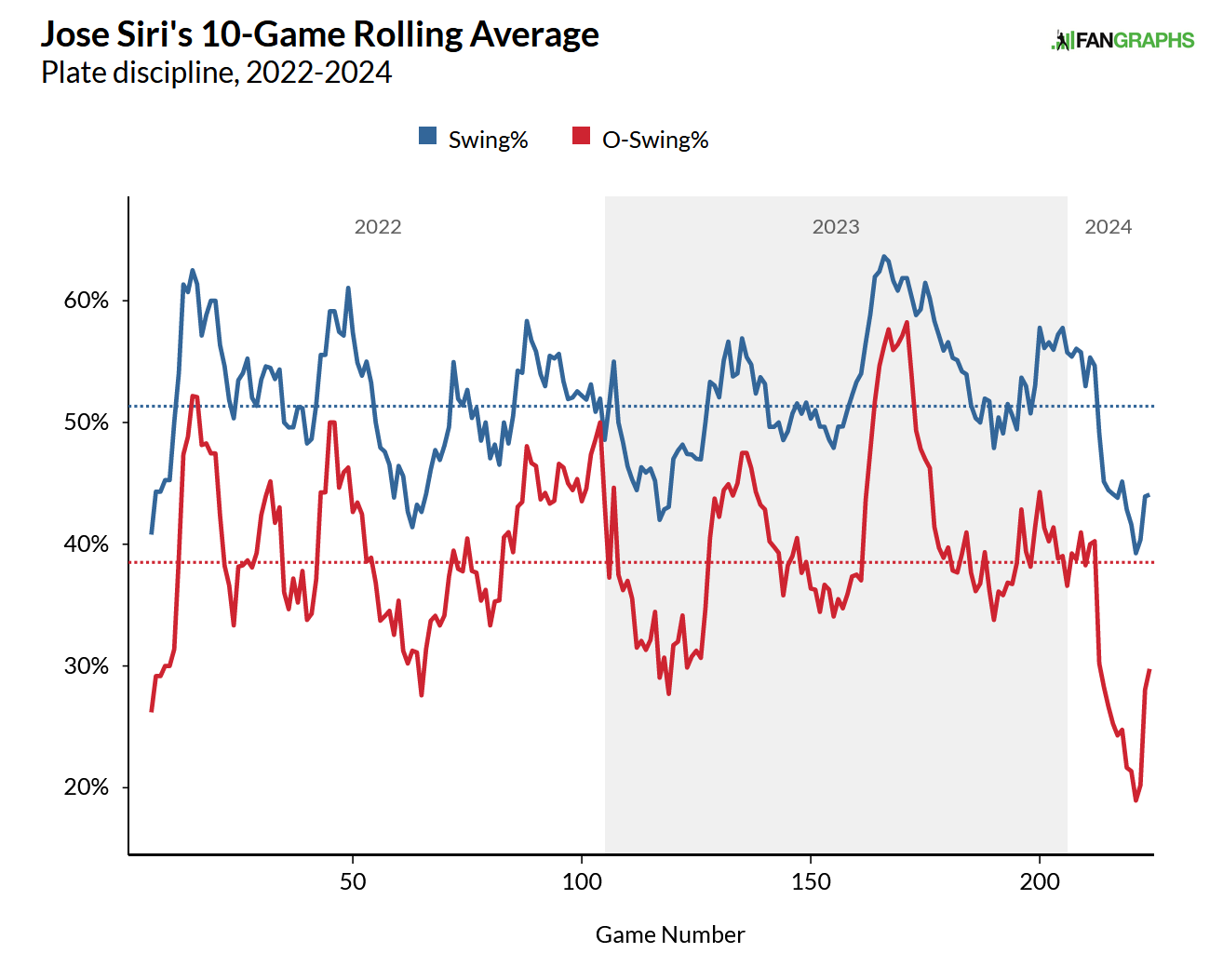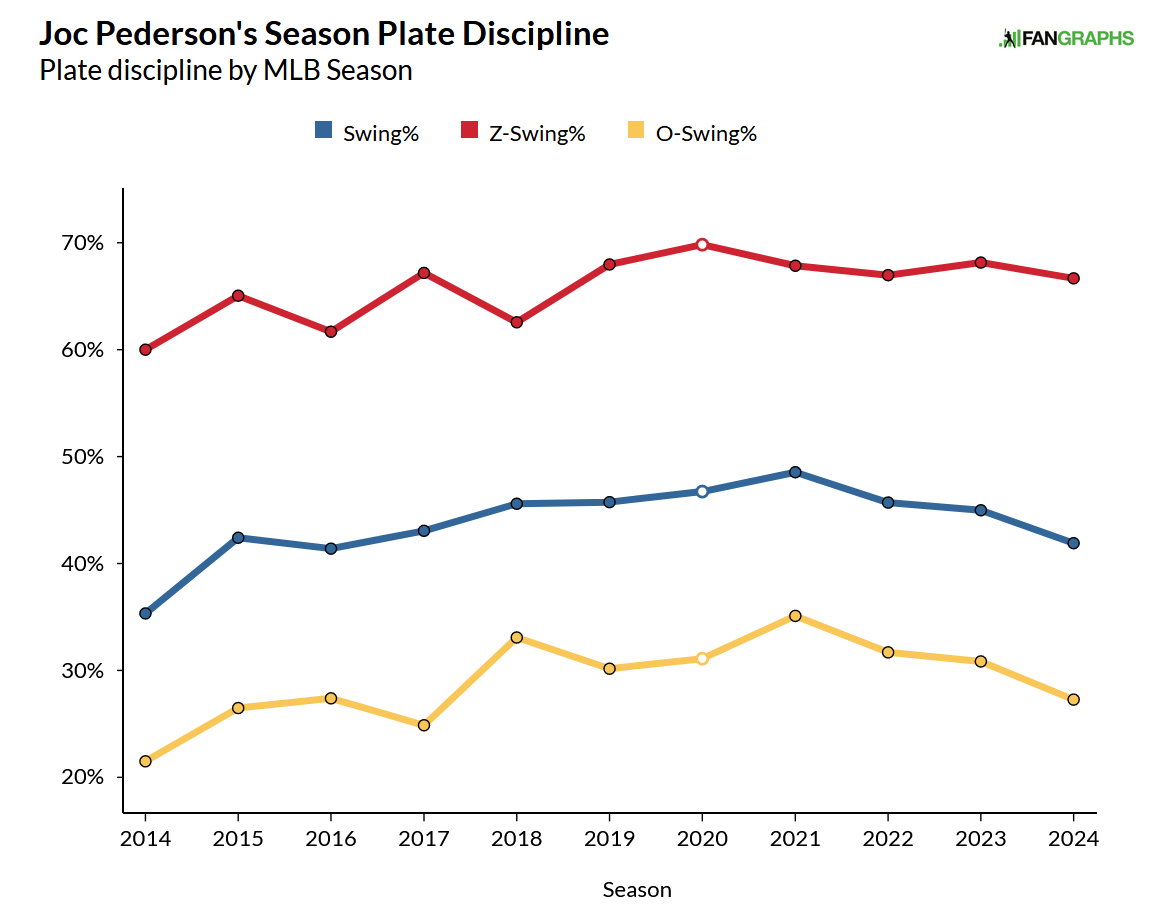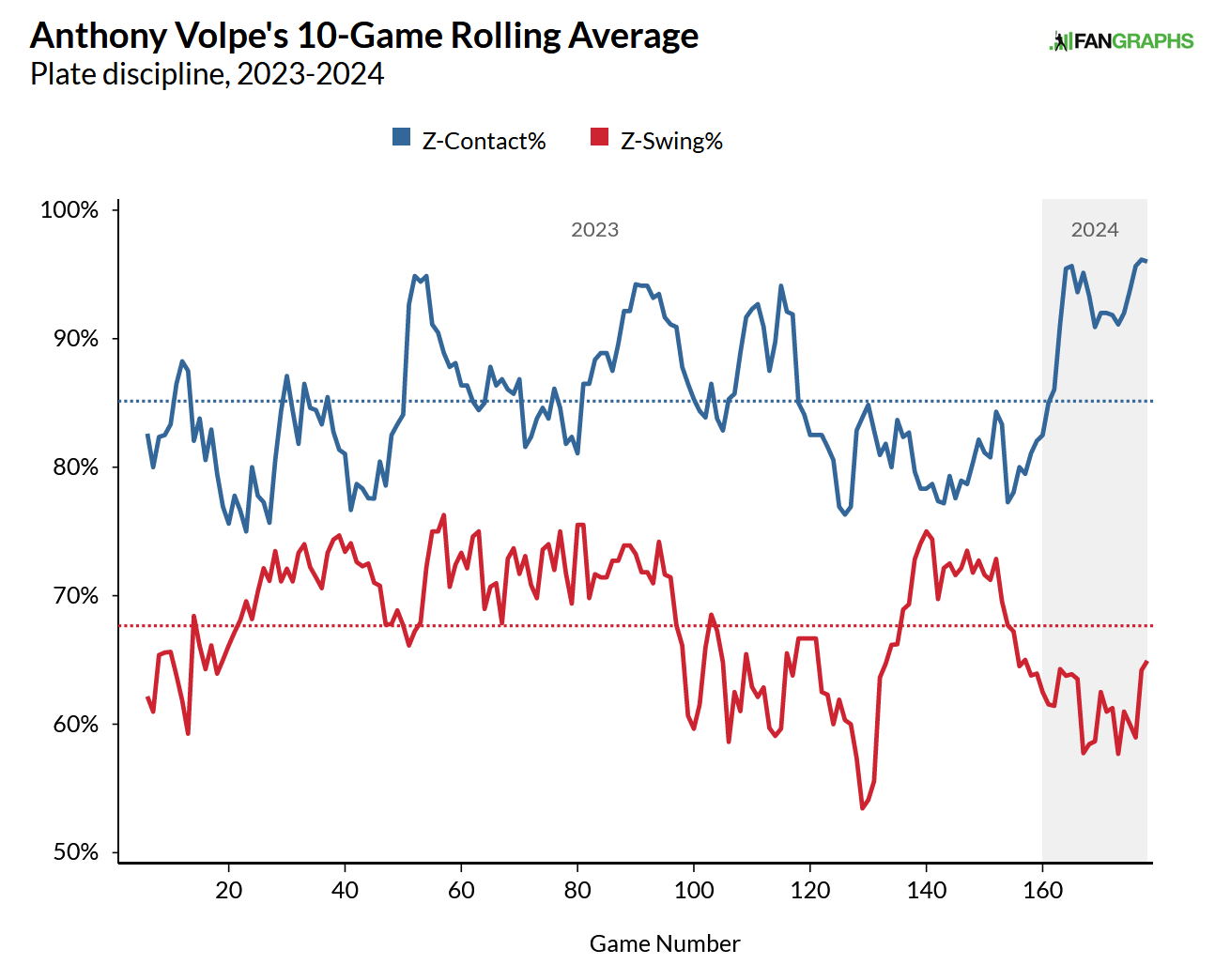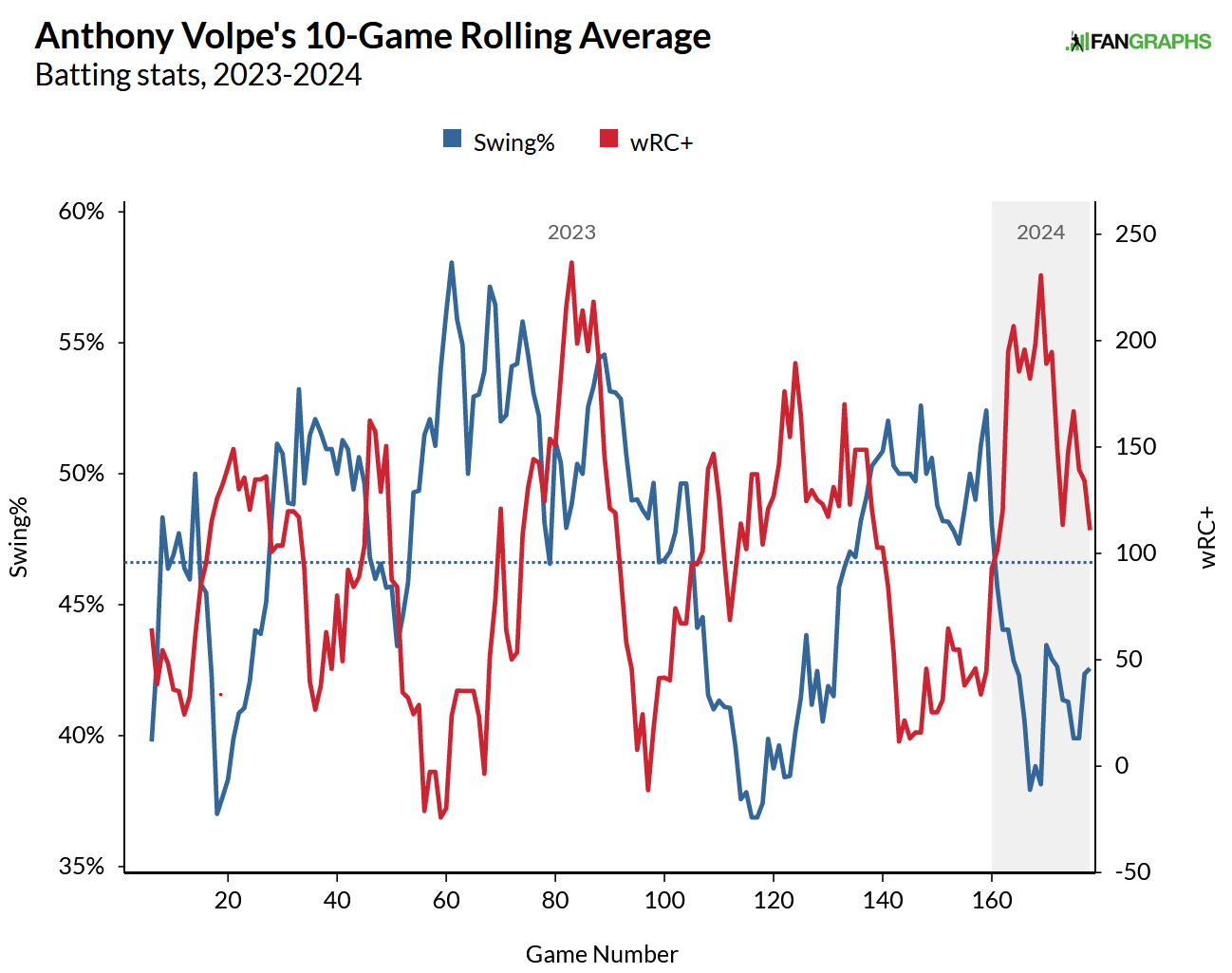This early in the season, it can be difficult to parse through data and come to confident conclusions on an individual player level. Small sample sizes are clouding our judgement and wreaking havoc on our ability to accurately evaluate performances, tempting us to take what we see at face value.
An area we can look at with reasonable confidence this time of year is per-pitch statistics, which tend to stabilize much more quickly. Stuff+, for example, becomes meaningful after only one or two outings for starting pitchers thanks to its more granular scope.
For hitters, one of the best early indications of changes in approach is movement in swing data. Overall swing rate (how often they swing at all pitches they see), swinging-strike rate (how often they swing and miss across all pitches), and chase rate (how often they swing at pitches outside of the strike zone) are among the few evaluative tools for hitters that are even remotely predictive in under 100 plate appearances, making them a great resource to identify potential performance change candidates at this early juncture.
With this in mind, let’s pick out a handful of batters who are seeing noticeable changes in their swing decisions and overall aggressiveness at the plate in the young season and discuss whether these changes look like they’ll be conducive to long-term success.
Jack Suwinski, PIT
I thought I’d kick things off with a guy who has been one of my personal favorite breakout candidates each of the last few offseasons, Jack Suwinski. After coming over from the Padres organization in 2021 as part of the deal that sent Adam Frazier to San Diego, Suwinski advanced through the Pirates Double-A and Triple-A affiliates before debuting in 2022.
His hallmark attribute as a prospect was his raw power, which helped him produce strong ISO’s in the upper levels of the minors and in his pseudo-breakout 2023 season in which he swatted 26 home runs with a 112 wRC+. The question with Suwinski was whether he was going to be able to control the whiffs enough to be a productive regular in Pittsburgh, as he maintained strikeout rates in the high 20’s as a minor leaguer.
That remains the most pressing question for him now that he’s a full-fledged big leaguer. He’s posted K rates north of 30% in each of his first two full seasons. This season, however, he’s pushed that figure all the way down to 17.5%. That’s a pretty significant improvement, but how has he managed to accomplish it?
Something that stood out about Suwinski over his first 700 major league plate appearances is that he was remarkably passive. One could look at his 22% chase rate in 2023 and say “Wow! This guy has exemplary plate skills!”, without realizing that figure was buoyed by a downright lethargic 38.9% overall swing rate that placed him among the 10 most passive hitters in the league.
Being exceptionally passive isn’t necessarily a detriment; Juan Soto had the 2nd lowest swing rate in the league last season. The difference between the two (aside from the fact that Juan Soto is Juan Soto) is that Suwinski was still failing to make consistent contact in the zone when he did choose to swing the bat. Pitchers started attacking him in the zone with breaking balls to capitalize on Suwinski’s approach, culminating in a 30.1% whiff rate and 32.2% strikeout rate.
This season, however, Suwinski has made it a point to swing the bat more on pitches in the strike zone, upping his zone swing rate from 61.1% to 74.2%. He’s also increased his zone contact rate by 12%, resulting in a much improved 16.9% whiff rate and 17.5% K rate in 2024. He’s chasing more as a result of his more aggressive approach, but he remains better than league average in that metric and is still drawing his fair share of walks.

The results aren’t there for Suwinski yet this year, evidenced by his 65 wRC+. Still, the strides he’s making at the plate shouldn’t go unnoticed. There is ample reason to be excited about a 25-year-old who has maintained better than a 10% walk rate and 12% barrel rate in each of his first two big league campaigns, especially now that he’s making conscious changes to his approach to rectify his strikeout issue.
With a more active swing approach at the plate, Suwinski will have more opportunities to leverage his plus raw power. Strengthening the output of his best fundamental tool is something he started to do a bit in 2023, but I think his new approach could allow him to fully capitalize on that 55/55 raw power grade he received as a prospect.
He hasn’t put it all together yet, but this looks an awful lot to me like a guy who is maturing rapidly as a hitter and could put up a monster season in the near future.
Jose Siri, TBR
On the opposite end of the swing-decision spectrum, we have Rays center fielder Jose Siri. Calling Siri an aggressive hitter prior to the 2024 season would have been an understatement; his 39.1% chase rate in 2023 ranked in the top 20 among players with at least 300 plate appearances.
Siri has always had a horrific whiff problem as well. His 43.4% whiff rate in 2023 was second in the league only to the king of swing and miss himself, Joey Gallo. Pair these two qualities, and you get a predictably awful 35.7% K rate that prevented him from fully capitalizing on his elite 29.7 ft/s sprint speed.
Siri remained a productive player despite his deficiencies at the plate thanks to his explosive raw power and standout defense in center field, but he was clearly going to need to make some changes if he was going to be anything more than a good defender who could take you deep every once in a while.
Enter 2024, where Siri is showing flashes of a more patient approach that is paying dividends early in the season for his particular skill set. He’s taken the opposite approach to Suwinski, cutting down his overall swing rate from 52.8% to 44.5%, leading to a much improved 28.4% chase rate. This has led to a 10% walk rate that is enabling Siri to finally use his legs more like he said he wanted to prior to the season.

It should be noted that this change in approach has not done much to remedy Siri’s strikeout problem thus far. In fact, he’s striking out even more often, repping an unsightly 41.4% rate. As someone who has watched a large portion of his 2024 plate appearances, I can confidently say, even without looking at the data, that his whiff problem remains with elevated heaters in the zone. But hey, let’s look at the data anyway.

That checks out. Honestly, judging by the fact that Siri is 28-years-old and has almost three full big league seasons of swing data we can look at, I doubt he’ll ever be able to put that big of a dent in his swing and miss issue. At his core, it seems like he’ll always be a guy who will run strikeout rates in the 30s barring any unprecedented changes in his swing.
That said, I like what he’s doing this year. Being a touch more patient is putting him in a position to pick out what pitches he really thinks he can drive. I don’t think he’s going to maintain a 10%+ walk rate over the entire season, as pitchers are sure to counter his new approach and get a bit more aggressive in the zone. Still, if he can walk even around 8% of the time, I think he could easily steal 30 bases along with his usual 20+ homer pop and elite defense.
The Rays are a team that is often willing to accept offensive deficiencies from defenders of Siri’s caliber, so his playing time should be pretty secure in Tampa Bay. If these approach changes stick, I think he’ll be a marginally better real-life and fantasy player than the guy we’ve seen over the past two seasons.
Joc Pederson, ARI
This is perhaps the most interesting case of a hitter drastically altering their process results that we’ve seen so far in 2024. Joc Pederson is a nine-year MLB veteran at this point in his career, and he’s carved out a fairly solid role as a big-side platoon bat that comes off the bench to mash right-handed pitching.
With that pop against righties comes a fair amount of swing-and-miss, but not as much as many of the players of his particular profile. Pederson seemed to have settled into his life as a 20-25% K rate, 8-12% walk rate hitter with the ever-present ability to drive the ball out of the park. Early in 2024, however, we’re seeing a totally different hitter.
Pederson currently owns the lowest strikeout rate among all qualified major league hitters at just 4%, and his 14.8% whiff rate on the year would go down as an easy career low were he to maintain it throughout the season. The most interesting aspect of this change is that Pederson’s swing decisions aren’t as drastically different from his career norms compared to the other hitters I’ve talked about here.

He’s chasing a bit less than he’s tended to, and that’s been a positive trend for him since 2022, but his general zone aggression and overall swing rate haven’t shifted too dramatically. For a guy as tenured as Pederson, significant changes in chase rate are pretty rare and tend to normalize with more exposure. Still, I wouldn’t discount this entirely just yet.
While his overall zone swing rate hasn’t budged much, he’s being far more aggressive on the most hittable pitches he’s been seeing. He’s swung at 91% of the pitches he’s seen in the heart of the zone this year compared to his career average of around 75%. Pair that with a marginally improved 85% zone contact rate, and it makes sense that he’s not whiffing as much so far this year.
Again, I don’t think the foundation here is as solid as someone like Suwinski, who has come much closer to completely overhauling his approach at the plate. Comparatively, Pederson is just optimizing his swing decisions in the zone without really increasing or decreasing his overall aggression.
Similar to Suwinski, however, I think more frequent swings at hittable pitches will afford Pederson more opportunities to put that gorgeous, leveraged left-handed swing to use. He’s always lofted the ball in the air well, leading to good power outcomes season-to-season. With the 2024 swing profile we’ve seen from him, I think he could potentially be adding a new dimension to his offensive game.
I would expect his 2024 strikeout and whiff rates to regress back to near his career averages, but maybe he’s figured something out with pitch recognition this season that can result in better process rates than we’re accustomed to seeing from him.
Anthony Volpe, NYY
Out of all qualified major league hitters, Anthony Volpe currently owns the greatest 2023-2024 improvement in whiff rate, slashing that figure by over 14% thus far. He serves as an interesting juxtaposition to the aforementioned Suwinski, as Volpe has achieved great results by dialing back his aggression instead of intensifying it.
When discussing Suwinski, I mentioned how he’s upped his zone contact rate by being more aggressive on pitches in the strike zone and giving himself more opportunities to make contact. In contrast, Volpe’s zone contact rate has spiked in 2024, even while being accompanied by a much more passive approach.

The divergence we’re seeing in those two figures is particularly interesting in Volpe’s case. Coming up as a prospect, his plate skills were among his most marketable and projectable traits. What we’re seeing in 2024 might just be a delayed porting over of the discipline he showed throughout the minor leagues.
It’s also incredibly easy to justify this change and diagnose what went wrong for him in his rookie season. Some hitters just respond much better to more passive approaches, especially when they have naturally strong pitch recognition skills that allow them to make better, more informed swing decisions. Volpe appears to be one of those players, as he is clearly at his best when he doesn’t feel the need to swing the bat too frequently.

There is a strong inverse correlation between Volpe’s aggression and his overall run production, and he seems to be stepping to the plate with that in mind thus far in 2024. For a hitter who is still just 22-years-old, it’s good to see a sensible adjustment like this. While you can’t guarantee these new rates are going to hold, I suspect this is just part of Volpe’s maturation as a major league hitter and an early indicator of real skills growth.
Volpe’s 2023 rookie campaign may have been slightly disappointing on the surface, but he managed to put up a 20/20 season with good defense at a premium position at just 21, even with suboptimal swing decisions. Now that he’s showing signs of being able to adjust to how big league pitchers attack him, I think his outlook as a hitter looks much better than it might have towards the end of last season.
We can’t be sure that the changes we’ve seen from these four hitters are going to stick for the entire season, but it’s always good to do some exploration into the process when we see notable performance changes early in the season. It’s an easy way to get out in front of potential breakouts and identify players you may want to fade if you get a whiff of skills deterioration.
From a fantasy perspective, pitch-level data are some of the only resources we have to be able to make early calls on borderline hitters, so looking over changes in swing frequency can be among the earliest indicators of potential growth. In many cases, being able to make those tough early calls can make a huge difference in your league and allow you to jump on breakout hitters.
At its foundation, baseball is a game of constant adjustment. Pitchers are always tinkering with their pitch mixes and shapes, and hitters need to adapt to changing attack patterns from opposing pitchers. At the very least, the approach changes we’ve seen from the hitters I’ve mentioned here display a willingness to shake things up at the plate. That alone makes me much more excited to see how these players progress throughout this season.
Photos Courtesy Icon Sportswire | Adapted by Aaron Asbury (@aarongifs on Instagram)


Any thoughts on Riley Greene? Notably an 8% decrease in swing%, buoyed by a 12% decrease in z-swing%